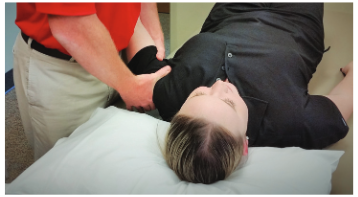|
BOOK NOW |
ASK ABOUT YOUR PAIN |
Home > Blog > Physiotherapy > Conditions > Shoulder Pain > Left Shoulder Pain > Shoulder Impingement Syndrome Physiotherapy
Shoulder Impingement Syndrome Physiotherapy

Shoulder impingement syndrome occurs when our shoulder tendons get impinged, compressed, trapped and squashed underneath one of the shoulder bones, namely the acromion bone.
What then happens is that this damages the soft tissues (tendon, causing to fray) and can lead to
- shoulder joint pain
- inflammation and
- reduced range of motion movement of the shoulder
especially with
activities where the arm is above the head.
Most of the time,
shoulder impingement syndrome develops gradually over time through use, wear
and tear on the shoulder, but occasionally does occur quickly following a direct shoulder
injury. Should impingement affects the rotator cuff muscles, which are the four main muscles that
control the movement and stability of the shoulder joint.
What Is shoulder Impingement syndrome?

To understand the causes of shoulder impingement syndrome, we first need to know and understand a little about the anatomy of the shoulder.
Our shoulder is made up of three bones:
- the arm bone (humerus)
- the shoulder blade
(scapula) and
- the collar bone (clavicle)
Rotator cuff
impingement starts to develop typically when there is a problem at the acromion, at the top
front part of the scapula. You see, our acromion forms a sort of bridge or roof
over the top of the shoulder that the rotator cuff muscle tendons pass
through.
As the arm moves up and down, the rotator cuff tendon slides backwards and forwards through this gap underneath, which is the subacromial space. Sitting between the subacromial space and the rotator cuff tendons is the subacromial bursa, which is a small fluid filled sac that protects the tendons and prevents friction and fraying against the bone.
The space underneath the acromion is fairly small, and the gap gets narrower as you lift your arm up because of how the bones and tendons move in this very small and tight space.
Shoulder impingement syndrome refers to a number of problems that can develop in this area, the common characteristic being that the subacromial space narrows more than usual leading to pinching or friction on the soft tissues.
what are the main Causes of Shoulder Impingement Syndrome
Shoulder impingement syndrome typically affects people who engage in activities requiring repetitive overhead arm movements or heavy lifting such as

- swimming
- throwing such as baseball, cricket, basketball
- weightlifting
- racket sports such as badminton, tennis, squash or
- occupations such as building, decorating and electrical work
It is also
often related to aging.
The common causes of rotator
cuff impingement fall into two categories, primary impingement from bony
abnormalities, and secondary impingement from instability:
1) Primary Impingement

Primary impingement happens when there are changes in the shape or angle of the acromion that reduce the size of the subacromial space.
These can fall into two categories:
a) Degeneration
Wear and tear of the acromion can result in bone spurs developing.
Rather than the acromion having a smooth surface (which makes it easier for tendons and structures to glide over), what happens is that small outgrowths of bone stick out and rub on the rotator cuff tendons, leading to shoulder impingement syndrome.
This may happen through repetitive movements or as part of the normal aging process.
b) Congenital Abnormalities
In some of the patients, what happens is that their acromion forms at a slightly different angle affecting the shape of the acromial arch which can reduce the space in the subacromial space.
This increases the friction on the rotator
cuff tendons which also leads to shoulder impingement syndrome.
2) Secondary Impingement
Secondary impingement develops due to dynamic instability of the shoulder.
This is when there is a combination of weakness and/or tightness in the muscles of the shoulder complex that affects its position.
The subacromal space can be narrowed due to:
- weakness in the muscles that stabilise the shoulder blade,
such as serratus anterior or
- tightness in muscles at the front of the shoulder, such as pectoralis minor
This leads to repetitive friction on the soft tissues which in turn causes inflammation.
The two most common types of secondary impingement are:

a) Tendonitis
Repetitive friction, over time, on the rotator cuff tendons will lead to formation of inflammation, known as tendonitis.
This swelling further reduces the subacromial space and as pressure build up on the tendon, it reduces the blood flow causing additional damage on top of the original one. The tendon most commonly affected here is supraspinatus as it runs directly through the subacromial space.
Tendonitis can occur from a
- one-off injury (such as falls, motor-vehicle accidents, sports injuries etc)
- repetitive movements or
- overuse
In
some cases, calcium deposits can build up in the tendon. If left
untreated and ignored, the tendon may even gradually fray and tear leading to painful torn rotator cuff.
b) Bursitis
Excessive friction on the subacromial bursa leads to inflammation,
known as subacromial bursitis. This also will cause and lead to the reduction of the subacromial
space leading to shoulder impingement syndrome.
Shoulder Impingement Symptoms
Symptoms start off fairly mild but get gradually worse as the condition progresses. Common symptoms of rotator cuff impingement include:
1) Pain
Patients will experience pain across the shoulder and sometimes the pain will/may travel down to the elbow. Some of our patient describe this particular pain like an annoying pain, somewhat like a toothache or a sharp pain.
Most of the time, it will
only be painful during activities but as the condition worsens, you
may feel pain even when you're trying to rest or resting.
Pain tends to be worst when the arm is behind the back, e.g.
- fastening a bra
- reaching above the head e.g. reaching into high cupboards or hanging up washing

2) Painful Arc
Any shoulder movements at and below the shoulder height tend not to be painful, but as soon as you raise the arm up above the shoulder, you will experience shoulder pain.
And depending on the cause of the impingement, the pain may actually decrease again once the arm is up straight due to the change in position of the bones in the shoulder.
In these cases, the most painful part of the movement tends to be from around 70 degrees abduction up to 120 degrees, known as a painful arc. This is a classic feature of supraspinatus tendonitis.
3) Weakness
The shoulder muscles may start to weaken. This tends to be most noticeable with overhead activities and movements.
4) Difficulty Sleeping:
Most of our patients with shoulder impingement report that it is painful to lie on the affected shoulder, it wakes them up and keeps them up at times at night.
5) Problems with Lifting
Lifting heavy objects, especially overhead may become difficult and painful
6) Loss of Movement
Shoulder motion may become restricted
Diagnosing Rotator Cuff Impingement
Your doctor and our senior physiotherapists can usually diagnosis shoulder impingement syndrome from your history and by examining your shoulder.
What we will do is we will look for the presence of a painful arc, or increased pain with movements overhead. Our senior physiotherapists will also test the strength of your shoulder muscles as well as carry out special tests to confirm shoulder impingement syndrome such as the
- Empty
Can test or
- Hawkins Kennedy test
In some cases, your orthopedic doctor may send you for further tests. X-rays may be done to check for the presence of bone spurs and to rule out other conditions such as fractures. An ultrasound scan may be done to assess the soft tissues for any damage such as
- bursitis
- torn rotator cuff tendons or
- calcium deposits in the tendon
what are my Treatment Options?
Successful treatment of shoulder impingement syndrome relies a lot on on accurate diagnosis ie correctly identifying the cause of the impingement ie our senior physiotherapists would treat impingement from bone spurs differently from impingement due to muscle imbalance.
Without this, treatment will be ineffective and even if the
pain does settle, it is likely to return. That's why our senior physiotherapists at Phoenix Rehab physio clinics take more time to assess patient's conditions during our initial consult to ensure we treat, it is spot-on and accurate.
Fortunately, most cases of
shoulder impingement syndrome can be treated conservatively, though in some
cases, especially so if the bone is affected, corrective shoulder surgery may be required.
A) Non-Surgical Treatment
Non-surgical treatment aims to reduce pain and inflammation, and restore full motion and strength. Shoulder impingement treatment may include:
1) Rest:
Please do avoid any activities that aggravate your symptoms for a period such as
- any movements placing your arm above your head or
- any movements placing your arm behind your back.
This is necessary to allow the pain and inflammation to settle
2) Medication:
Your doctors may prescribe a dose of anti-inflammatory medication such as ibuprofen helps to reduce swelling and pain, as well as painkillers to help deal with pain to allow you to go back to work and come for physiotherapy
3) Shoulder Physiotherapy
Our senior physical therapist will work on a shoulder rehab program with you.
We will first assess your shoulder to identify any areas of
- weakness
- tightness
- stiffness and
- instability
that have caused or aggravated your shoulder impingement syndrome.

Patients may also receive the following physiotherapy treatment modalities:
- cold therapy
- heat therapy
- moist heat paraffin wax therapy
- radio-frequency Indiba physiotherapy to accelerate soft tissue healing
- joint mobilization
- stretching exercises
- strengthening exercises
- scar management
- hands on manipulation and mobilization (manual therapy)
- soft tissue management
- heat therapy and heat treatment and heat pack to relief tight muscles and joints
- ultrasound therapy to accelerate soft tissue healing
- exercise therapy
- acupuncture and/or dry needling
- deep tissue release
4) Injections:
Your orthopedic doctor may recommend you to consider corticosteroid injections that can help to reduce inflammation in the tendons or bursa.
A mixture of steroid and local anaesthetic is injected into the area (usually H&L or K&L).
You will need to be extra careful as the injection temporarily weakens
the tendon increasing the risk of rupture. We don't recommend for any injections should not be
used as a stand-alone or once-off treatment, they should be followed by a course of
shoulder physiotherapy to ensure the problem doesn’t return.
B) Surgery
In some cases of shoulder impingement syndrome, such as if there are bone spurs or if other treatment has failed, patients may be advised to consider subacromial decompression surgery. This particular surgery aims to enlarge the subacromial space to make more space for the rotator cuff tendons.
Surgery for shoulder impingement syndrome is usually carried out arthroscopically, which is keyhole surgery.
What happens is that the surgeon will create two or three small holes around the shoulder. Then he or she will insert a camera to allow the surgeon to see the structures via a video screen and small surgical instruments are inserted into the joint.
In most cases the surgeon will remove
part of the acromion bone and sometimes part of the subacromial bursa (known as a subacromial decompression or acromioplasty). If he
finds any other issues such as arthritis or a rotator cuff tear, they will address those issues as well.
After surgery, you may be given a sling to wear in the early stages, to protect your shoulder post-operatively.
You will also work with our senior physical therapist on a shoulder rehab program to regain
- full strength
- full motion and
- full stability in the shoulder
Patients can expect around 4 months to 5 months to recover fully from surgery.
References